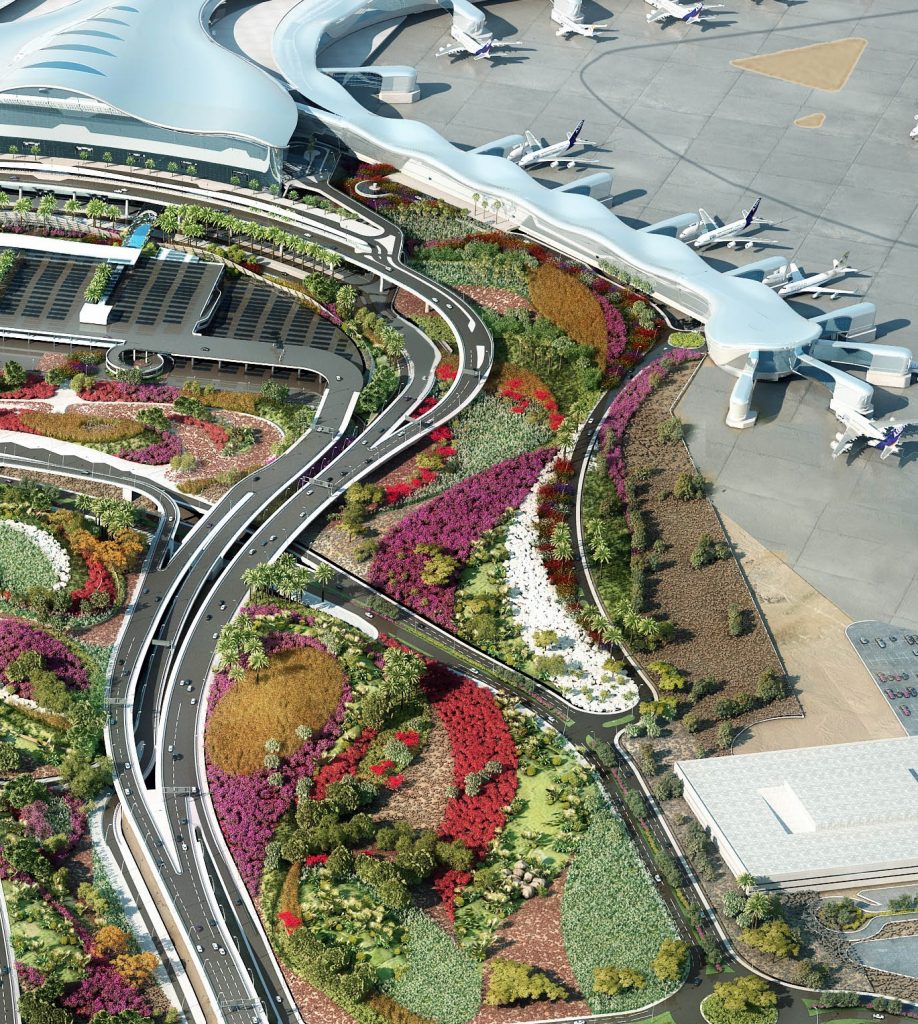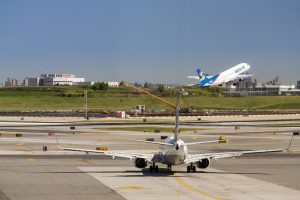Airport innovations take off
For the next generation of airports, innovation is essential in building faster, smarter and better. Pointing the way to the future, aviation technology leader Kevin Carlson picks his top six aviation innovations.
As the number of air passengers continues to soar, so too do expectations for the entire passenger experience – including efficiency, safety, health and comfort, value, sustainability, and, of course, great shopping. According to the International Air Transport Association (IATA), global scheduled passenger flight numbers are forecast to top four billion for the first time this year with anticipated revenues for commercial airlines of almost $750 billion. According to the IATA, passenger demand remains strong and is “well ahead of both the five- and 10-year average rates (6.4% and 5.5%, respectively).”
To address all of these areas for improvement, airport innovations play a crucial role in creating and operating the next generation of airports. Here we showcase some of the outstanding advances being made around the world.
Airport innovations: safety
The layout and geometry of taxiways and runways plays a crucial role in ensuring that aircraft remain on a safe pathway in and out of airports. Not surprisingly, as the traffic increases at a complex airfield, so does the risk of runway incursion. With good design being a powerful tool to reduce risk, the U.S. Federal Aviation Administration (FAA) commissioned an unprecedented national-scale design analysis of the runways at all public use airports, numbering more than six thousand. Using aerial imagery, every airfield layout was assessed and classified. Cloud-hosted mapping software was built and applied to analyze the links between non-standard airfield design and more than six years of recorded incursions, between 2007 and 2013. AECOM conducted this piece of research and continues to support the FAA with new safety-based analytics and dashboards.
Airport innovations: landscape
 Creating a positive passenger experience is one of the keys to airports attracting repeat business and new customers. And one of the routes to improving the journey starts with the physical experience of the terminal. Designed to enhance this experience and reflect the environment and culture of the United Arab Emirates (UAE), the distinctive and sustainable landscape design for the Abu Dhabi International Airport, Midfield Terminal Complex, creates a scenographic journey for travellers. Incorporating gentle arabesque forms, the 170 hectare site frames and reveals the building to visitors as they pass through the rippling topography, grass meadows, boulder fields, and groves of trees. The low-water planting palette is coupled with smart irrigation to create one of the most sustainable landscapes in the UAE achieving an Estidama 3 Pearl rating. Working with the complex’s architect Kohn Pedersen Fox, AECOM’s London landscape architecture studio designed the interior and exterior landscapes.
Creating a positive passenger experience is one of the keys to airports attracting repeat business and new customers. And one of the routes to improving the journey starts with the physical experience of the terminal. Designed to enhance this experience and reflect the environment and culture of the United Arab Emirates (UAE), the distinctive and sustainable landscape design for the Abu Dhabi International Airport, Midfield Terminal Complex, creates a scenographic journey for travellers. Incorporating gentle arabesque forms, the 170 hectare site frames and reveals the building to visitors as they pass through the rippling topography, grass meadows, boulder fields, and groves of trees. The low-water planting palette is coupled with smart irrigation to create one of the most sustainable landscapes in the UAE achieving an Estidama 3 Pearl rating. Working with the complex’s architect Kohn Pedersen Fox, AECOM’s London landscape architecture studio designed the interior and exterior landscapes.
Airport innovations: sustainability
Achieving impressive sustainability standards is always tough given the necessity of high demands for energy and other resources. Additionally, airports are increasingly challenged through public expectations, regulation and cost reduction to operate efficiently. Using the latest innovative thinking, the $1 billion Green Build project at San Diego International Airport in the U.S. focused on improving the passenger experience while also creating a smart approach to energy use and efficiency airport-wide. The energy plan work includes installation of 8MW onsite solar to support the airport’s commitment to use low carbon energy sources with a target of 100% renewable energy use by 2030. Under the plan, a 30% reduction in energy consumption is expected by 2030. In terms of resilience, the airport’s electrical system is able to operate at critical levels for up to 24 hours in the event of a grid outage.
The Green Build terminal expansion has been recognised with awards including the Leadership in Energy and Environmental Design (LEED) Platinum from the U.S. Green Building Council (USGBC). The award makes San Diego International Airport home to the first LEED Platinum certified commercial airport terminal in the world. AECOM was Engineer of Record, and program manager, partnering with the San Diego County Regional Airport Authority to drive sustainability as a core part of the design solution.
Airport innovations: planning
Building strong and positive relationships with local communities is a vital part of airports being good neighbors and successful regional economic growth engines. Two web-based tools have been created and implemented to improve communications with local residents and business communities. In Western Australia, the Perth Airport Protected Airspace Assessment Tool (PAAT) is a web-based method to provide the community, particularly construction industry developers, with the ability to determine the potential impacts of their construction on airport operations. This can include proposals for the erection of cranes and tall cellphone masts that may infringe the Obstacle Limitation Service. This web-based tool allows the proponent an instant response and supersedes a paper-based time-consuming process. Similarly, to connect with communities in Melbourne, a public consultation website is being built to communicate the new masterplan for the city’s airport including requirements in the future for new roads, additional runways, and transit services. AECOM developed the PAAT tool and supported the design of the Melbourne Airport Masterplan website developing interactive GIS maps and plans.
Airport innovations: financing
 In this era of constrained public finances and growing demands for improved infrastructure, innovative funding mechanisms are offering ways to speed up the route to delivery. At New York’s LaGuardia Airport, a deal is now in place using the public-private-partnership (P3) model for replacing the Central Terminal Building — the largest P3 in American history. The work forms part of New York City’s vision to transform the airport into a world-class hub. P3 works where scarce public funds can be leveraged with billions in private capital to accelerate complex, large-scale projects with a lifecycle guarantee of delivery that is on time and within budget, and where innovation, efficiency, transparency and customer service are hallmarks. While this model is used throughout much of the world it is limited in the U.S. because it breaks the traditional approach to developing, funding, building and managing infrastructure assets. For this groundbreaking transaction, AECOM served as the P3 technical advisor in support of LaGuardia’s owner — the Port Authority of New York and New Jersey.
In this era of constrained public finances and growing demands for improved infrastructure, innovative funding mechanisms are offering ways to speed up the route to delivery. At New York’s LaGuardia Airport, a deal is now in place using the public-private-partnership (P3) model for replacing the Central Terminal Building — the largest P3 in American history. The work forms part of New York City’s vision to transform the airport into a world-class hub. P3 works where scarce public funds can be leveraged with billions in private capital to accelerate complex, large-scale projects with a lifecycle guarantee of delivery that is on time and within budget, and where innovation, efficiency, transparency and customer service are hallmarks. While this model is used throughout much of the world it is limited in the U.S. because it breaks the traditional approach to developing, funding, building and managing infrastructure assets. For this groundbreaking transaction, AECOM served as the P3 technical advisor in support of LaGuardia’s owner — the Port Authority of New York and New Jersey.
Airport innovations: security
With ever-increasing risks of threat to the whole aviation industry, the importance of smart security measures at airports has never been higher. Forging stronger links between the Los Angeles International Airport control center and workers based around the facility, a mobile, tablet-based tool has been developed. A vital hub for operations, maintenance, energy and security, the Airport Response Coordination Center is now able to share information and collaborate instantly with all staff working in the field. The tool provides round the clock contact and updates on a huge range of issues from routine building maintenance to the safe movement of passengers and negotiating road closures. AECOM designed and implemented this system in partnership with Qognify.






